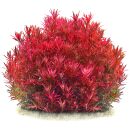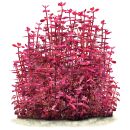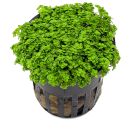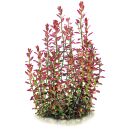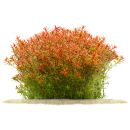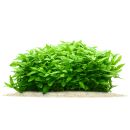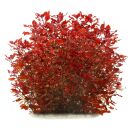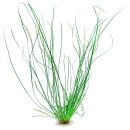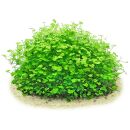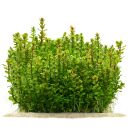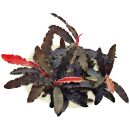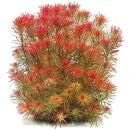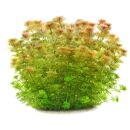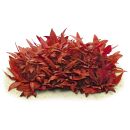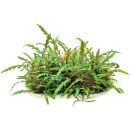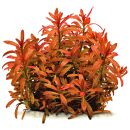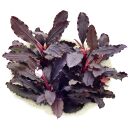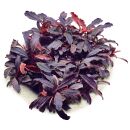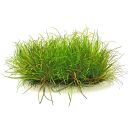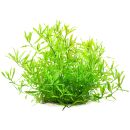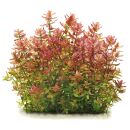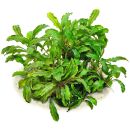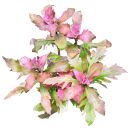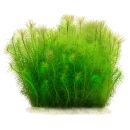Be it aquatic plants, waterplants, aquascaping plants or aquarium plants - we have the right one for you
Water plants - as the name already implies, are first of all plants that occur naturally where you get wet feet. Not only below the water surface (submersed), but also growing outside of the water (emersed), with floating leaves on the water surface (floating leaf plants) or floating freely on the surface (floating plants).
Most aquarium plants are natural species, that are able to grow under water. But also some floating leaf plants and floating plants are kept in aquariums, and half emersed plants, protruding from the water surface are very decorative in open tanks. By now hundreds of suitable species are known. They originate mainly from the tropics and subtropics, but also from the temperate zones of the earth - basically from all continents except Antarctica.
Aquatic plants have been used since the beginning of freshwater aquaristics in the 19th century. The biological aspect was often the focus; aquarium plants, as oxygen producers and excess-nutrient absorbers, contribute decisively to a healthy environment for fish and other aquarium inhabitants. The aesthetic value of aquarium planting gained in importance, and advances in aquarium technology and many newly introduced aquatic plant species made it possible to create beautiful plant aquariums. Variety breeding, especially in Echinodorus, has also expanded the selection of aquarium plants. Modern trends such as aquascaping and nano aquariums are contributing to an increased interest in new aquarium plants. Not all aquarium plants are regularly available on the market as many are rarities. In our shop we have a large assortment of aquarium plants, including some true rarities.
Only a small part of the many aquarium plants in nature grow exclusively under water - such as Vallisneria-, Blyxa-, coontails (Ceratophyllum)- and waterweed (Egeria)- species. Such species cannot thrive outside the water. All other aquarium plants, on the other hand, are able to grow both submersed and emersed or as pure land plants on damp soil. Such amphibian aquatic plants originate from biotopes in which the water decreases depending on the season or the weather, or which occasionally fall completely dry. The plants then develop a land form (emersed form) and often will only then bloom and carry fruit. Nevertheless, they can be cultivated permanently in their underwater form without any problems. Some aquarium plants are also distinct swamp plants in nature that are normally only under water for a short time, such as Penthorum sedoides, which also grows uninhibited under water in aquariums.
This adaptation to a life in "two worlds" is utilized in aquarium plant cultivation in the nurseries. Most of the aquarium plants are cultivated in their emersed form there, and you can buy them in our online shop as potted plants in their land form. This has several advantages, for example the plants in the nursery usually grow faster until they are ready for sale and are not infested by algae. Emerse aquatic plants are generally also vigorous, with large energy reserves, making it easier for them to adapt to underwater growth in the aquarium.
When they transform into their underwater form, many aquarium plants change their appearance considerably. The fresh leaves are usually softer and often narrower or have a finer pinnate, also they often show other colours. For example, many Rotala- and Echinodorus-forms develop a magnificent red coloration only when inside the aquarium and under water, while emersed plants have green, coarser leaves. Their older leaves, which have formed into their emersed form above water, do not usually change again when put under water (this can happen with Cryptocorynes), but eventually they will die off and can be removed. Sometimes it is recommended to cut off all emersed-form leaves of e.g. Echinodorus and Crypts immediately before planting, so that they do not disturb the viewing experience later. However, the plants must be strong and need to have enough reserve for new shoots. It is rather advantageous for the plants if they retain the old foliage in the conversion phase because they draw nutrients from it.
However, some plants do not show that striking differences between their emersed and submersed forms. This concerns mostly slow-growing epiphytic plants such as the Java fern (Microsorum pteropus), Anubias- and Bucephalandra-species. They come from the flood zones of streams, where the water level changes frequently. Their emersed-form leaves are also fully functional under water and will remain intact for a long time. Healthy emerse leaves should therefore not be removed from such plants before they are placed in the aquarium.
A distinction is made between the following plant types: Stem plants are certainly the most common plant species for aquariums, for example from the genera Bacopa, Rotala, Ludwigia and Pogostemon. Rosette plants such as water trumpets (Cryptocoryne) and sword plants (Echinodorus). Plants with thin creeping shoots or stolons like Glossostigma elatinoides, Eleocharis-species, Hemianthus callitrichoides "Cuba" and Micranthemum tweediei (also known as Micranthemum sp. "Montecarlo"). Rhizome plants such as Anubias and slow-growing ferns like Congo fern (Bolbitis heudelotii) and Java fern (Microsorum pteropus). Tuber plants like cape-pondweed (Aponogeton) and tropical water lilies (Nymphaea), which are also rosette plants. Bulb plants, which are represented in aquaristics by the Crinum species, can also be counted as rosette plants. Mosses (regular aquatic mosses and liverworts), so-called fern prothallia and algae such as the "moss ball" Aegagropila linnaei do not fit into this pattern. They are available in our online shop under the category "Mosses".
Detailed instructions for preparing and planting your aquatic plants can be found in our Wiki article Preparing aquatic plants.
More recently, in vitro plants have become very popular. Young plants are produced in tissue culture under sterile laboratory conditions and sold directly in their culture cups. More detailed information can be found in our Wiki article Tissue-culture or potted plants. We offer many aquarium plants in their in-vitro version in our online shop w.
Depending on their properties, the plants can be used differently for aquarium layouts. Low-growing runner plants are ideal for the aquarium foreground and play an important role as groundcovers in aquascaping. Decorative materials such as stones and root wood - the hardscape - are covered by epiphytes and mosses. For the middle and background there are many medium-high and high aquarium plants. Larger rosette plants such as Echinodorus and Aponogeton are suitable as solitaires, while most stem plants and narrow-leaved rosette plants work best as a group or larger bush. Medium cryptocorynas are recommended rosette plants for the middle ground, which form dense stands with stolons, require little light and show a vast variety of colours and textures. Stem plants can be easily shaped and propagated by pruning and planting cut shoots. The height of rosette plants depends on the species or variety.









